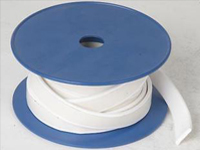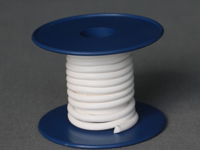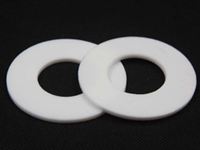Expanded PTFE, or Polytetrafluoroethylene, is a highly versatile, microporous material engineered through a unique expansion process. This process stretches the base PTFE polymer, creating a matrix of fine, interconnected fibrils and nodes that result in exceptional properties such as high strength-to-weight ratio, excellent chemical resistance, and outstanding thermal stability. Unlike standard PTFE, which is solid and non-porous, expanded PTFE offers a unique combination of flexibility, durability, and porosity, making it an ideal solution for a wide range of demanding applications across various industries, including filtration, medical devices, electrical insulation, and sealing technologies.
To understand the superior performance of expanded PTFE, it is essential to review its core material properties. The following parameters highlight why this material is a preferred choice in critical applications.
For engineers and specifiers, the following table provides a comprehensive overview of the typical specifications available for expanded PTFE products. These values can vary based on manufacturing processes and specific product grades.
| Property | Standard Test Method | Typical Value Range | Units |
|---|---|---|---|
| Density | ASTM D792 | 0.1 - 1.2 | g/cm³ |
| Tensile Strength (Machine Direction) | ASTM D882 | 10 - 100 | MPa |
| Elongation at Break | ASTM D882 | 50 - 400 | % |
| Porosity | ASTM D2873 | 20 - 95 | % |
| Mean Flow Pore Size | ASTM E1294 | 0.1 - 30.0 | µm |
| Bubble Point | ASTM F316 | 10 - 500 | kPa |
| Thermal Shrinkage (30 min @ 300°C) | Internal Method | < 5 | % |
| Dielectric Strength | ASTM D149 | 20 - 60 | kV/mm |
| Coefficient of Friction (Dynamic) | ASTM D1894 | 0.05 - 0.15 | - |
What is the primary difference between standard PTFE and expanded PTFE?
Standard PTFE is a solid, non-porous polymer known for its chemical resistance and low friction. Expanded PTFE is created by mechanically stretching PTFE, which creates a microporous structure of nodes and fibrils. This structure gives expanded PTFE unique properties such as flexibility, high tensile strength, controlled porosity, and gas permeability, which are not present in the standard, solid form. It is this porous matrix that allows ePTFE to be used in applications like filtration membranes, vents, and seals where breathability or controlled fluid passage is required.
How is the porosity of expanded PTFE controlled during manufacturing?
The porosity of expanded PTFE is precisely controlled through a multi-step manufacturing process. It begins with the mixing of fine PTFE powder with a lubricant to form a paste. This paste is then extruded into a specific shape and calendered. The critical expansion step involves rapidly stretching the material longitudinally and/or transversally at elevated temperatures. The rate of stretch, temperature, and the degree of stretch directly determine the density, pore size, and overall porosity. Post-expansion treatments like heat setting (sintering) can lock in the microstructure and further refine the pore characteristics for specific performance needs, such as higher strength or specific filtration ratings.
Can expanded PTFE be used for high-purity fluid filtration?
Yes, expanded PTFE is an excellent material for high-purity fluid filtration. Its inherent chemical inertness ensures it does not leach contaminants or react with the process fluids. The membrane can be manufactured with very precise and consistent pore sizes, allowing for absolute-rated filtration where all particles larger than the specified pore size are retained on the surface. This makes it ideal for critical applications in the semiconductor, pharmaceutical, and food and beverage industries. Furthermore, its hydrophobic nature repels water, making it particularly effective for filtering gases and solvents, preventing clogging from moisture.
Is expanded PTFE biocompatible and suitable for medical implants?
Absolutely. Expanded PTFE is highly biocompatible and has a long history of safe use in numerous medical implants and devices. Its microporous structure allows for tissue ingrowth and integration, which is beneficial for vascular grafts, soft tissue patches, and sutures. The material is non-toxic, non-pyrogenic, and does not elicit a significant immune response. It also exhibits high stability within the human body, resisting degradation. Medical-grade expanded PTFE is manufactured under strict quality controls and complies with relevant international standards, such as USP Class VI and ISO 10993, for biological evaluation of medical devices.
What are the key considerations for sealing applications using expanded PTFE?
When using expanded PTFE for sealing, several factors are critical. First, its conformability allows it to seal effectively on rough or irregular surfaces, compensating for flange imperfections. Its chemical resistance ensures long-term integrity when exposed to aggressive media. The wide temperature range makes it suitable for both cryogenic and high-heat services. For dynamic seals, its low coefficient of friction and self-lubricating properties reduce wear and power consumption. It is also important to select the correct density and form—such as tapes, cords, or custom-molded gaskets—based on the specific pressure, temperature, and chemical service conditions. Proper gland design and bolt load are also essential for optimal seal performance.
How does the thermal stability of expanded PTFE compare to other high-performance polymers?
Expanded PTFE offers exceptional thermal stability, comparable to and often exceeding that of many other high-performance polymers. Its continuous service temperature range of -240°C to 260°C is among the widest available. Unlike many thermoplastics that melt, PTFE and ePTFE do not have a true melting point but instead transition through gel states at very high temperatures (around 327°C), maintaining dimensional stability and mechanical integrity. This makes it more suitable for extreme temperature cycling than materials like PEEK or Polyimide in certain applications. Its resistance to thermal degradation and low thermal expansion coefficient contribute to its reliability in demanding thermal environments.






